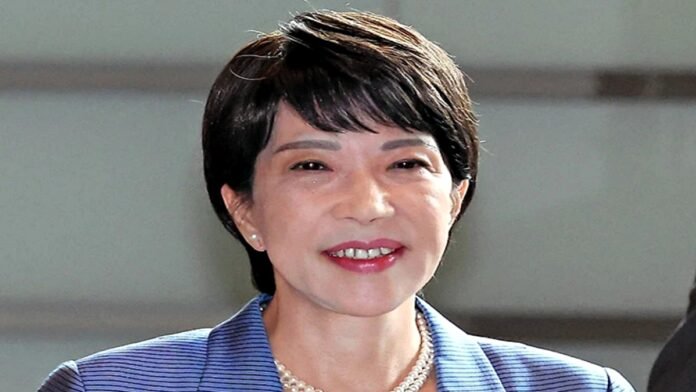
Key Points
- Sanae Takaichi elected as Japan’s first female Prime Minister on October 21, 2025, following parliamentary vote
- Wins Upper House with 125 votes (one above majority); secures 237 votes in Lower House
- Elected LDP leader on Saturday with 185 votes, defeating rival Shinjiro Koizumi’s 156 votes
- Will complete former PM Shigeru Ishiba’s term running until September 2027
- Former TV anchor who entered politics in 1993; served as Internal Affairs Minister and Economic Security Minister
- PM Modi congratulates Takaichi, pledges to strengthen India-Japan partnership
- Faces major challenges, including economic recession, inflation, weak yen, and LDP’s minority government status
- First woman to lead LDP Policy Research Council; longest-serving Internal Affairs Minister in Japanese history
Tokyo: In a groundbreaking moment for Japanese politics, Sanae Takaichi was elected as the nation’s first female Prime Minister on Tuesday, October 21, 2025, shattering one of the most enduring glass ceilings in democratic governance. The 64-year-old conservative politician’s historic victory in parliamentary voting marks a watershed moment for gender equality in a country where women remain significantly underrepresented in political leadership despite being one of the world’s most advanced democracies.
Parliamentary Vote Confirms Historic Leadership
The Japanese Parliament, known as the Diet, conducted voting in both its chambers to formally elect Takaichi as Prime Minister following her weekend victory in the Liberal Democratic Party (LDP) leadership race. The bicameral legislative process required majorities in both the House of Representatives (Lower House) and the House of Councillors (Upper House).
In the Upper House, Takaichi secured 125 votes just one vote above the 124 required for a simple majority. The razor-thin margin reflects the political fragmentation and challenges she faces in governing. The narrow victory suggests some members of her own party or coalition partners held reservations, foreshadowing potential difficulties in maintaining parliamentary support for her legislative agenda.
The Lower House vote proved more comfortable, with Takaichi receiving 237 votes, comfortably exceeding the majority threshold. As the more powerful of Japan’s two legislative chambers, the Lower House vote carries particular significance in establishing governmental legitimacy and authority.
The voting process concluded a whirlwind political transition triggered by the resignation of former Prime Minister Shigeru Ishiba, whose brief tenure ended amid mounting economic challenges and the LDP’s poor performance in recent elections. Takaichi will now serve out the remainder of Ishiba’s term, which extends until September 2027, giving her approximately two years to demonstrate her leadership capabilities before facing voters in a general election.
LDP Leadership Race
Takaichi’s path to the premiership began with her victory in the LDP leadership election held on Saturday, October 18, 2025. In a closely contested race that required multiple rounds of voting, she ultimately prevailed over her principal rival, Shinjiro Koizumi, the 44-year-old son of former Prime Minister Junichiro Koizumi.
The first round of voting failed to produce a clear winner, necessitating a runoff between the top two candidates. In the decisive second round, Takaichi secured 185 votes compared to Koizumi’s 156, a margin of 29 votes that demonstrated substantial but not overwhelming support within the party.
The competitive nature of the leadership race highlighted generational and ideological divisions within the LDP. Koizumi represented a younger generation seeking to modernize the party’s image and policy approach, while Takaichi embodied conservative continuity aligned with the legacy of former Prime Minister Shinzo Abe, under whom she served in multiple cabinet positions.
Her victory suggests the party’s rank-and-file members and parliamentarians prioritized experience and proven loyalty over generational renewal, at least for the immediate crisis management period Japan faces. However, the strong showing by Koizumi indicates significant internal pressure for eventual reform and younger leadership.
From TV Anchor to Prime Minister
Sanae Takaichi’s journey to Japan’s highest political office began far from the corridors of power. Before entering politics, she worked as a television anchor, gaining public visibility and communication skills that would later prove valuable in political campaigns. Her media background distinguishes her from many Japanese politicians who follow more traditional paths through bureaucracy or family political dynasties.
In 1993, Takaichi made her initial foray into electoral politics as an independent candidate, successfully winning an election to the House of Representatives from Nara Prefecture, her home district in the Kansai region of central Japan. The timing of her entry coincided with a period of political turbulence in Japan, as the LDP’s decades-long monopoly on power temporarily fractured.
Recognizing the advantages of major party affiliation, Takaichi joined the LDP in 1996, strengthening her political foundation and gaining access to party resources and networks. Since then, she has consistently won reelection from her Nara constituency, building a loyal local support base while rising through party ranks.
Cabinet Experience and Leadership Roles
Takaichi’s cabinet career began under former Prime Minister Shinzo Abe, whose conservative nationalist vision deeply influenced her political philosophy. Her first ministerial appointment came as Minister of State for Okinawa and Northern Territories Affairs, handling sensitive issues related to Japan’s southernmost prefecture and disputed territories with Russia.
Her administrative competence and political loyalty led to additional responsibilities, most notably her appointment as Minister of Internal Affairs and Communications, a position she held longer than any previous officeholder, male or female. This ministry oversees crucial portfolios including telecommunications, broadcasting, postal services, local government administration, and fire and disaster management.
More recently, from 2022 to 2024, Takaichi served as Minister of Economic Security, a newly created position reflecting growing concerns about supply chain vulnerabilities, critical technology protection, and economic dimensions of national security amid rising geopolitical tensions with China.
In a particularly significant achievement for gender representation, Takaichi became the first woman to chair the LDP’s Policy Research Council, the party’s principal policy formulation body. This position placed her at the center of legislative agenda-setting and demonstrated her intellectual heft and political acumen to party colleagues.
Breaking Barriers in Male-Dominated Politics
Japan’s political landscape has remained stubbornly resistant to female leadership despite women’s strong presence in Japanese society, economy, and education. Women comprise only about 10% of House of Representatives members and roughly 26% of House of Councillors members, far below global averages and ranking Japan near the bottom among developed democracies in political gender equality measures.
Cultural factors, including traditional gender roles, corporate structures discouraging women’s career advancement, and political recruitment patterns favoring male candidates, have combined to create formidable barriers to women’s political participation. Many female politicians face additional scrutiny regarding appearance, family responsibilities, and perceived “feminine” qualities that their male counterparts rarely encounter.
Former Justice Minister Midori Matsushima, one of 20 LDP parliamentarians who supported Takaichi’s leadership bid, expressed the historic significance of the moment. Speaking to reporters after the parliamentary vote, Matsushima stated that having Japan’s first female Prime Minister represented not just a personal victory for Takaichi but a breakthrough for all Japanese women aspiring to leadership roles.
Matsushima emphasized that Takaichi’s success would inspire young women and individuals without family political connections—so-called “hereditary politicians” who dominate Japanese politics showing that political leadership remains accessible through merit, experience, and determination rather than exclusively through inheritance or traditional male networks.
International Reactions
International leaders moved quickly to congratulate Takaichi on her historic achievement. Indian Prime Minister Narendra Modi stated within hours of the parliamentary vote, emphasizing the strong strategic partnership between Japan and India and expressing confidence that bilateral relations would deepen under Takaichi’s leadership.
The India-Japan relationship has strengthened significantly in recent years, driven by shared democratic values, economic complementarity, and strategic concerns about China’s growing assertiveness in the Indo-Pacific region. Both nations participate in the Quadrilateral Security Dialogue (Quad) alongside the United States and Australia, coordinating approaches to regional security and prosperity.
Modi’s prompt congratulations reflect India’s prioritization of the Japanese relationship and eagerness to work with Takaichi’s government on defense cooperation, technology partnerships, infrastructure investment, and regional security coordination. The two nations have cultivated close ties through regular summit meetings, joint military exercises, and expanding economic engagement.
Other world leaders, including US President Donald Trump, British Prime Minister, and European Union officials, also extended congratulations, noting the historic nature of Takaichi’s election while expressing continuity in their nations’ partnerships with Japan.
Formidable Challenges Ahead
Takaichi assumes office at one of the most challenging moments in modern Japanese political and economic history. The confluence of domestic economic difficulties, international security tensions, and political fragmentation creates an extraordinarily complex governing environment.
Japan’s economy, the world’s third-largest, has struggled with persistent stagnation despite decades of unconventional monetary policy. Economic growth remains anemic, with GDP expansion barely keeping pace with population decline and aging. The “lost decades” that began with Japan’s asset bubble collapse in the early 1990s have continued with only brief interruptions, leaving the nation searching for sustainable growth models.
Inflation has emerged as a new challenge after decades of deflationary pressure. Rising global commodity prices, supply chain disruptions, and the weak yen have pushed consumer prices higher, eroding purchasing power for Japanese households accustomed to stable or declining prices. The Bank of Japan faces difficult decisions about whether to maintain ultra-loose monetary policy or begin normalization that could trigger financial instability.
The Japanese yen has weakened significantly against major currencies, particularly the US dollar, falling to multi-decade lows. While yen weakness theoretically benefits exporters by making Japanese products more price-competitive internationally, it simultaneously increases import costs for energy, food, and raw materials, contributing to inflation and reducing living standards.
Political Fragmentation
The LDP’s recent electoral setback has left Takaichi leading a minority government requiring coalition support or case-by-case cooperation from opposition parties to pass legislation. This precarious parliamentary arithmetic severely constrains her policy options and forces continuous negotiation and compromise.
Internal party dynamics present additional challenges. The competitive leadership race revealed divisions that Takaichi must navigate carefully to maintain party unity. Disappointed supporters of rival candidates may withhold full cooperation, while different LDP factions pursue competing policy priorities and positioning for future leadership contests.
Opposition parties, sensing government vulnerability, will likely adopt aggressive parliamentary tactics, blocking or delaying legislation, demanding investigations into administrative actions, and using their positions to embarrass the government and position themselves for eventual electoral gains.
Policy Priorities and Vision
Takaichi has signaled that economic revitalization will be her administration’s top priority. She advocates a combination of fiscal stimulus, structural reforms, and strategic industrial policy to jumpstart growth and address Japan’s competitiveness challenges in emerging technologies, including artificial intelligence, robotics, renewable energy, and biotechnology.
Her economic security background suggests continued emphasis on supply chain resilience, critical technology protection, and reduced dependence on geopolitically risky suppliers. This approach aligns with broader trends among democratic nations seeking to “de-risk” economic relationships with authoritarian states while maintaining beneficial trade and investment flows.
On foreign policy, Takaichi is expected to maintain close US alliance ties while strengthening regional partnerships with nations including India, Australia, South Korea, and Southeast Asian democracies. Her conservative nationalism suggests a firm approach to territorial disputes with China and South Korea, though pragmatic considerations may moderate rhetoric versus substantive policy.
Defense policy will likely see continued gradual expansion of Japan’s military capabilities and more proactive security posture, building on initiatives begun under Abe and continued by subsequent administrations. Constitutional constraints on military action remain politically sensitive but may face renewed debate.
Gender Equality Implications
Takaichi’s election as Prime Minister creates obvious symbolism for women’s political participation, but does not automatically translate into broader gender equality advances. Her conservative political orientation includes traditional views on family structure and gender roles that diverge significantly from feminist advocacy positions.
Critics note that Takaichi has not prioritized women’s rights issues during her political career and has sometimes opposed policies favored by gender equality advocates, including proposals for separate surnames for married couples and expanded childcare support. Her leadership style emphasizes competence and results rather than gender identity or feminist solidarity.
Nevertheless, the simple fact of a woman occupying Japan’s highest political office normalizes female leadership in ways that may gradually shift cultural attitudes and inspire younger women to pursue political careers. Representation matters even when the specific individual does not champion gender-focused policies.
Historical Significance
Japan becomes one of the last major democracies to elect a female head of government, joining nations including Germany, the United Kingdom, India, New Zealand, and numerous others that have previously crossed this threshold. The delayed achievement reflects Japan’s particular cultural and political characteristics rather than a lack of capable female politicians.
Takaichi’s tenure will be closely watched both domestically and internationally as a test case for whether gender diversity in political leadership produces different policy outcomes, governing styles, or political dynamics. Academic research on this question has produced mixed findings, with some studies identifying modest differences in policy priorities while others emphasize similarities across gender lines when controlling for party affiliation and ideological orientation.
For Takaichi personally, the historic nature of her achievement coexists with the immediate practical challenges of governing during a crisis. She must balance symbolic importance as Japan’s first female Prime Minister with demonstrating concrete policy effectiveness and political skill that transcends gender considerations.
The coming months will reveal whether Takaichi can navigate Japan’s daunting challenges while maintaining parliamentary support and public confidence. Her success or failure will shape not only her own political legacy but also perceptions of women’s readiness for top leadership roles in Japanese politics for years to come.


















































